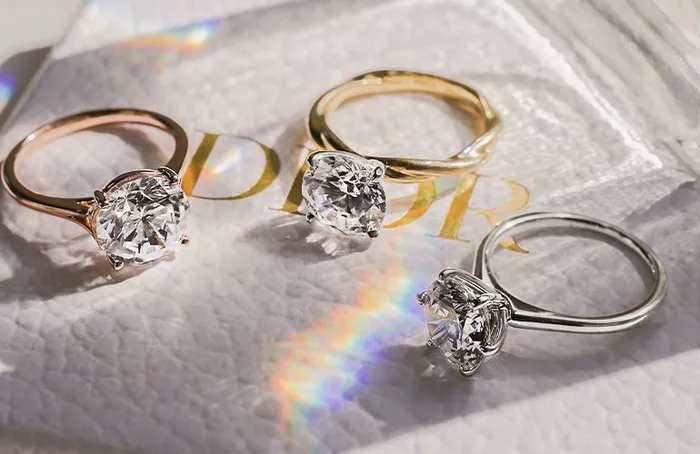Diamonds have long been cherished for their beauty, durability, and symbolic meaning, especially in the context of engagement rings and other fine jewelry. Whether you’re purchasing a diamond ring or verifying the authenticity of an existing piece, knowing how to assess its quality at home is invaluable. This comprehensive guide will equip you with the knowledge and tools necessary to confidently evaluate a diamond ring’s cut, color, clarity, and carat weight from the comfort of your own home.
Understanding the Basics of Diamond Evaluation
Before diving into the evaluation process, it’s essential to understand the fundamental characteristics that determine a diamond’s quality:
Cut: The cut of a diamond refers to its proportions, symmetry, and polish. A well-cut diamond reflects light brilliantly, creating sparkle and enhancing its overall appearance.
Color: Diamonds are graded on a scale from D (colorless) to Z (light yellow or brown). Colorless diamonds are the most valuable, as they allow maximum light reflection.
Clarity: Refers to the presence of internal (inclusions) and external (blemishes) characteristics within the diamond. Clarity is graded on a scale ranging from Flawless (FL) to Included (I), with higher clarity grades indicating fewer imperfections.
Carat Weight: Measures the size and weight of the diamond. One carat is equivalent to 0.2 grams, and larger diamonds typically command higher prices per carat due to their rarity.
Essential Tools for Home Diamond Testing
Before starting the evaluation, gather the following tools to assist in assessing the diamond’s quality:
Jeweler’s Loupe: A magnification tool, usually 10x magnification, to examine the diamond’s facets and identify any inclusions or blemishes.
White Paper or Cloth: Provides a neutral background against which to view the diamond’s color and brilliance.
Diamond Tester: Optional but recommended for testing thermal conductivity, distinguishing between diamonds and diamond simulants like cubic zirconia.
UV Light (Blacklight): Helps detect fluorescence in diamonds, which can affect their appearance under different lighting conditions.
Step-by-Step Guide to Checking a Diamond Ring at Home
Follow these detailed steps to conduct a thorough assessment of a diamond ring:
Inspect the Diamond Setting and Mounting:
Examine the metal setting (e.g., gold, platinum) for quality marks (e.g., 14K, 18K) and signs of wear or damage.
Ensure the diamond is securely mounted and centered within the setting.
Examine the Diamond’s Shape and Cut:
Identify the diamond’s shape (e.g., round, princess, oval) and assess its symmetry and proportions.
Use the jeweler’s loupe to inspect the diamond’s facets for evenness and brilliance. A well-cut diamond will exhibit excellent light reflection and sparkle.
Check the Diamond’s Color:
Place the diamond on a white surface and observe its color under natural light.
Compare its hue against a diamond color grading chart to determine its color grade (ranging from D to Z).
Evaluate Diamond Clarity:
Use the jeweler’s loupe to examine the diamond for internal inclusions and external blemishes.
Refer to a clarity grading chart to assess the diamond’s clarity grade (e.g., FL, IF, VVS1, VS2, SI1, I1).
Assess Diamond Carat Weight:
Verify the diamond’s carat weight as indicated by the seller or jeweler. Use a digital scale for precise measurement if necessary.
See Also: What Is the Largest Diamond Ring in the World?
Perform Basic Tests for Diamond Authenticity:
Use a diamond tester to verify thermal conductivity. Diamonds conduct heat quickly, distinguishing them from diamond simulants.
Shine a UV light (blacklight) on the diamond to observe fluorescence. Natural diamonds may exhibit blue fluorescence, which can impact their appearance.
Additional Tips for Checking Diamond Rings
Certification: Request a diamond grading report from reputable gemological laboratories such as GIA (Gemological Institute of America) or AGS (American Gem Society) for certified diamonds. These reports provide detailed assessments of the diamond’s 4Cs by independent experts.
Professional Appraisal: Consider obtaining a professional appraisal from a certified gemologist or appraiser. An appraisal provides an unbiased evaluation of the diamond’s quality, characteristics, and market value.
Trusted Sellers: Purchase diamond rings from reputable jewelers or established retailers known for their quality and customer service. Verify their return policies and authenticity guarantees before making a purchase.
Regular Maintenance: Schedule periodic inspections and cleanings for your diamond ring to maintain its brilliance and ensure the setting remains secure over time.
Conclusion
Checking a diamond ring at home requires careful attention to detail and the use of specialized tools like a jeweler’s loupe, diamond tester, and UV light. By following the step-by-step guide outlined in this article, you can confidently assess a diamond’s cut, color, clarity, and carat weight to determine its authenticity and quality. Whether you’re purchasing a diamond ring for a special occasion or verifying an existing piece, understanding these evaluation techniques empowers you to make informed decisions and appreciate the beauty and value of your diamond jewelry investment.

